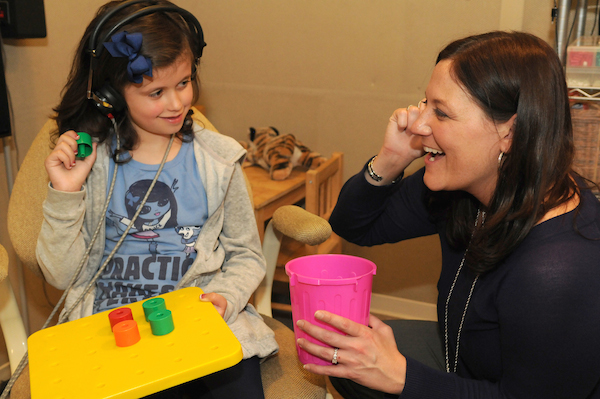Parents are sometimes ambivalent about having their children wear hearing aids. The results from the Outcomes of Children with Hearing Loss study showed that, for kids with mild hearing loss, there is direct relationship between the length of hearing aid usage and speech and language outcomes.
By Cheryl Tanita, Au.D., CCC-A, Chief of Audiology
Hearing loss is one of the most common health conditions in children. Universal hearing screenings were implemented in the 1990s based on extensive research on the detrimental effects of untreated hearing loss. There are varying degrees of hearing loss and parents are sometimes ambivalent about having their children wear hearing aids. I see it in our own practice: because of the challenges of getting children to consistently wear their hearing aids and the perceived stigma associated with it, parents often question whether hearing aids are really necessary, especially for mild hearing losses.
The results from the Outcomes of Children with Hearing Loss (OCHL) research study presented at the most recent American Academy of Audiology conference should interest any parent whose child has a hearing loss. The study looked at mild hearing loss and whether amplification should be considered for these children. It followed 90 kids ages six months to seven years for a period of four years and evaluated the effect hearing aid usage made on speech and language outcomes. Some kids wore hearing aids consistently (greater than 12 hours), some part time (3-11 hours) and some sporadically or not at all (2 hours or less). The results showed that the full-time hearing aid users had better language and phonological skills–specifically phonological memory–than non-users.
In summary, there is direct relationship between the length of hearing aid usage and speech and language outcomes. Researchers found that children who have a mild hearing loss and children with moderate or greater degrees of hearing loss receive the same amount of benefit contributing to speech and language development when they consistently wear amplification. In addition, they found one of the key factors to maximum benefit is audibility and the importance of using appropriate assessment tools to ensure hearing aids are well fit. For more on this subject, click here.
The research was conducted jointly by Boys Town National Research Hospital, the University of Iowa, and the University of North Carolina at Chapel Hill and was funded by the National Institute On Deafness And Other Communication Disorders of the National Institutes of Health. Be on the lookout for our next blog, which will discuss ways to get your children to wear their hearing aids.
